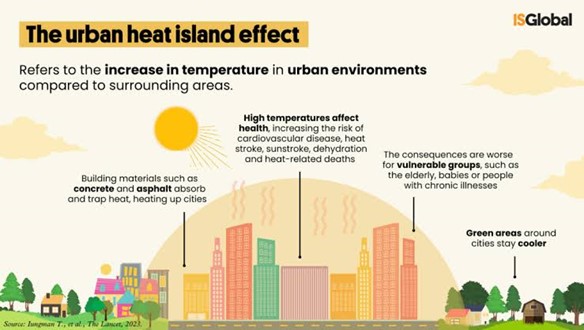India has been facing a severe heat crisis in recent times, including Delhi surpassing 50°C.urban heat island effect is a significant contributor to rising temperatures. The marginalised and poor are facing severe impacts of heat waves compared to the elite, demanding urgent attention.
Relevance: GS1 ( Geography, Society).
Practice question: Discuss the impacts of urban heat waves in India, with a special focus on marginalised communities. Suggest some important measures to mitigate the challenges. (250 words)
● The Urban Heat Island Effect (UHI)
The UHI effect, caused by human activities and heat-retaining materials like concrete and glass, makes cities significantly warmer than rural areas. Urban design worsens this effect, especially in modern corporate hubs like Gurugram, where sleek glass buildings increase energy consumption and heat retention.
A study from IIT Kharagpur remarks Urban areas can be 5-7°C hotter than rural areas.

● Impact on Marginalised Communities
Delivery workers, auto drivers, street vendors, construction labourers, and domestic workers are most affected due to constant exposure to heat, and limited access to hydration and shade.
E.g., According to the Lancet Countdown on Health and Climate Change, over 200 deaths were reported due to heatwaves in India in 2023.
● Technological Shield for Privileged Class
The rise of app-based services has enabled wealthier sections of society to remain indoors and avoid the heat, reducing interaction with the environment and their engagement with urban issues.
- Grocery apps, delivery apps, and doorstep repair apps have isolated elites from harsh extreme weather realities.
- A study by the Centre for Science and Environment (CSE) revealed that air-conditioned buildings in Indian cities contribute to a 10-15% rise in electricity demand during peak summer.
● Poor Urban Planning.
Urban planning in India has largely failed to account for sustainable growth and equitable access to infrastructure. This has worsened living conditions for marginalised groups, while the elite remain insulated.
E.g.: lack of green spaces in the urban areas to mitigate UHI effectively.
Way forward :
● Sustainable urban designs :
Promoting green infrastructure like tree covers, green roofs etc along with energy-efficient building designs :
● Policies :
Implementing stronger heat action plans, ensuring stricter building codes implementation.
● Public awareness :
Regarding heat waves and UHI impacts through community engagements.
Conclusion
The urban heat wave problem in India calls for urgent attention and a multifaceted approach to protect marginalised communities from getting severely affected. Sustainable urban planning, improved public services and social empathy are key areas of concern.



